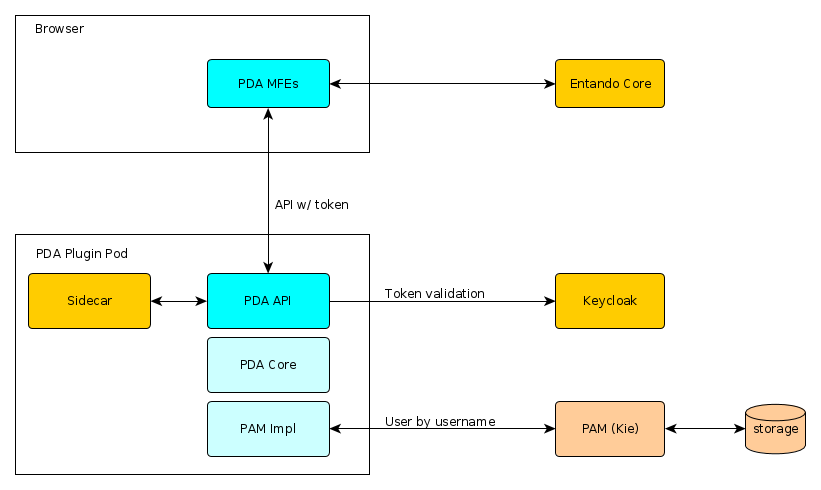# PDA Architecture
The objective of this document is to provide an explanation for the components that compose the Process Driven Applications plugin (PDA) architecture from a deployment perspective as well as how they interact with each other.
The image below shows the components in high level:

# PDA MFEs
The PDA Micro Frontends run on the browser and they render the UI custom components the user interacts with. These components are written in React and they fetch data from the PDA API, passing the Keycloak token for authentication. The MFEs also make calls to the Entando Core API in order to retrieve the settings required for the configuration UI. These components will be available on Entando App Builder after the PDA plugin bundle is installed and the user can create pages with them.
The source code for this component: https://github.com/entando/entando-process-driven-plugin/tree/master/widgets (opens new window)
# PDA API
The Spring Boot application that communicates with the engine and make its data available in a Rest API. It interacts with Keycloak to validate the token and with the sidecar to retrieve the connections/sensitive data, depending on how it was deployed. The application shouldn't call specific engine classes directly, instead it always calls the abstractions defined in PDA Core library. The engine implementation to use is decided at runtime based on the connection details provided. It is important to note that the PDA API application is stateless, since it doesn't have a database. All data available on the API is retrieved from the BPM engine. After bundle installation, it will be deployed as a microservice in the Kubernetes infrastructure and an Ingress will be created to make the API available to the MFEs, as described by the Entando Plugin custom resource.
The source code for this component: https://github.com/entando/entando-process-driven-plugin (opens new window)
# Sidecar
The sidecar is another application (docker container) deployed in the same Pod as the PDA API. It exposes services to manage connection details, which will be stored as secrets in Kubernetes. The PDA API communicates with the sidecar to manage BPM engine connection details.
The source code for this component: https://github.com/entando/entando-plugin-sidecar (opens new window)
# PDA Core
This is the library that defines the interfaces and abstractions that should be implemented to interact with specific BPM engines. This way it is possible to have multiple engine implementations at the same time.
The source code for this component: https://github.com/entando/pda-core-engine (opens new window)
# PAM Impl
The Red Hat PAM implementation for the PDA Core library. If the connection maps to a PAM engine, these are the classes that are going to be executed when the PDA API requests for engine operations. This implementation communicates with the Kie Server, which executes the defined process operations.
The source code for this component: https://github.com/entando/pda-redhatpam-engine (opens new window)